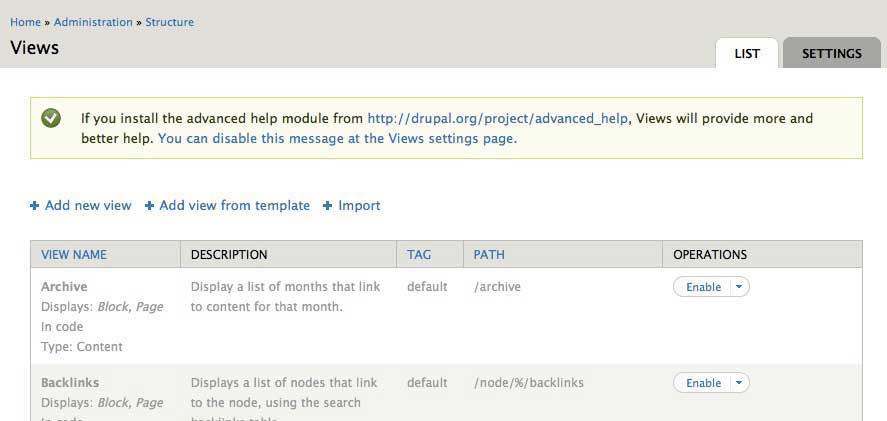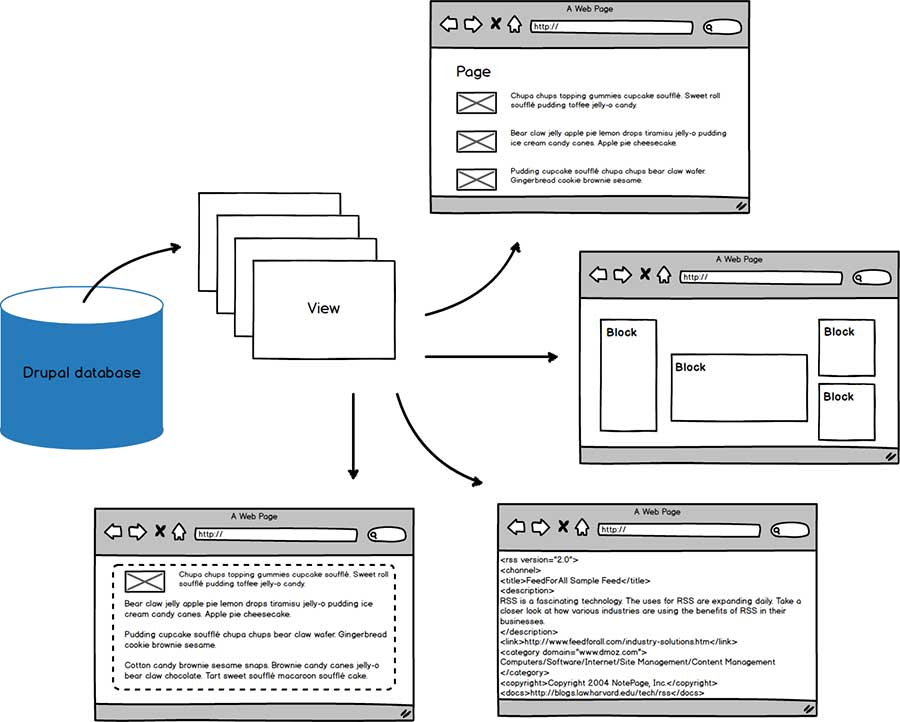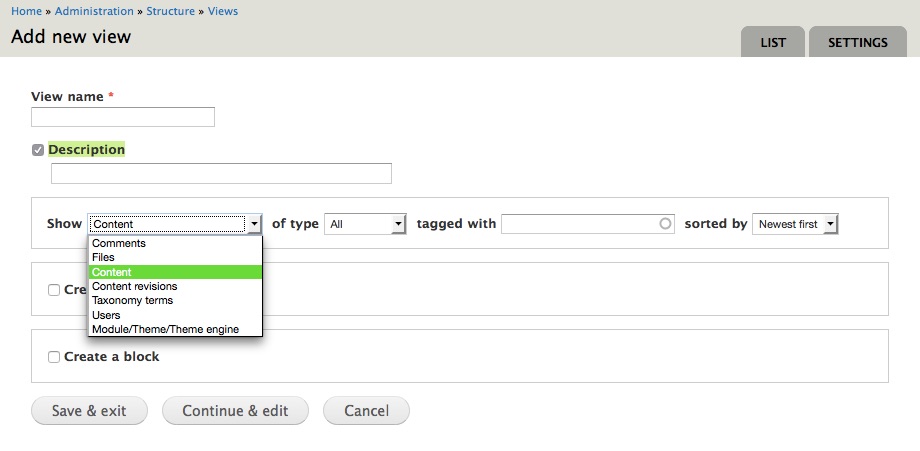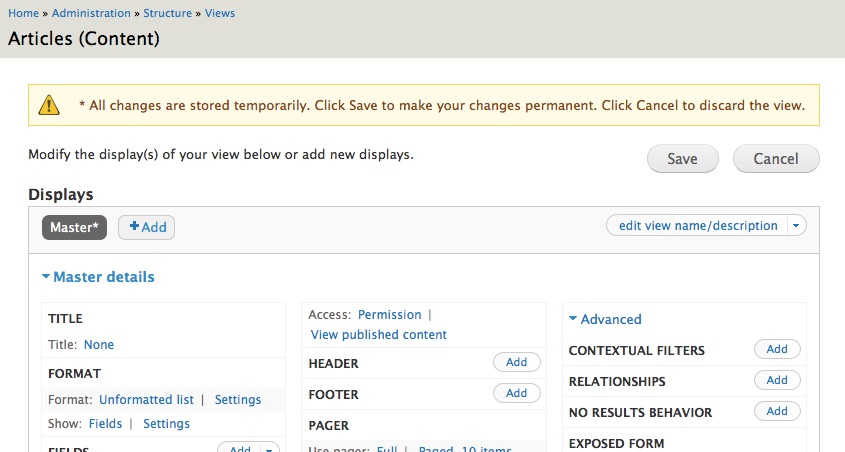Views is an extremely popular Drupal module. As of time of writing, it has been downloaded 6,294,998 times and reported to be used in 876,607 sites. It’s so popular, in fact, that it has been included in core for the Drupal 8. So why is Views such an essential module?
If you’re not one of the 6,294,998 people who downloaded Views, or if you did but somehow just couldn’t grok it and just uninstalled it again, you may be wondering what the fuss is all about. Fact is, I almost fell into the latter category. Even though using Views is pretty intuitive to me now, I can still remember when it felt as complicated as trying to land Curiosity on Mars. Let me try to sum it up in three words.
Views make lists.
That’s essentially what people use Views for. All the content created on Drupal is stored in a database, and Views allows us to filter and pull selected content from that database and display it in the form of a list. The official documentation can be found here and if you installed the Advanced Help module, you can access it directly from the Drupal admin.
Let’s start off by installing this module. You can download it from the Views project page on Drupal.org. Refer to Installing modules (Drupal 7) if you need help installing Drupal modules. As there is a dependency on the Chaos Tools Suite or CTools, you’ll have to install that module too. You have to enable the following 3 modules to use Views:
- Views
- Views UI --> If you miss this, you'll end up wondering why you can't get to the Views admin page
- Chaos Tools Suite
If you use Drush, use the following command to download and enable Views:
drush dl views
drush en views views_ui -y
This will install and enable all the required modules, including CTools, for you automatically.
Go to the Views administration page and you will see a list of Views that come out of the box with the module. They will all be greyed out as they are disabled by default. The only one that I actually use is Taxonomy Term but most of the time I create my own Views.

The settings tab provides some options that you can customise based on your preferences. If you have a lot of views, turning on the filters could help you find your view more easily. You can also change the admin theme of the Views UI. For those of you familiar with SQL, you may want to check Show the SQL query, under Live preview settings, for easier debugging of your view displays.
Here’s some terminology to get straight. A view is the selected content you pull from your database. Once you create a view, you can choose how to present this content through a variety of displays. We’ll call them view displays.

Clicking on ➕ Add new view will take you to the View creation wizard. It’s sort of a simplified version of the main Views editor. Here you can enter the name of your view and its description. For me, I tend to create views for each content type, as that’s how I structure my site data. But regardless, it’s always advisable to name your views in an understandable manner. It also helps to fill in the description to supplement your name. There are also basic filters you can apply.

Remember when I said Drupal stores all your content in a database? Well, a database is made up of lots of tables, so the Show drop-down lets you choose which base table your view will filter from. The most commonly used option will be Content, which are your nodes. I have also used Taxonomy terms and Users quite often, less so for the others. Depending on which base table you chose, there will be more settings and options you can choose.
You can also choose to create a page or a block right off the bat and be done with it by clicking Save & exit. But odds are, you need to do some more to get the view looking exactly how you want it. So go ahead and click Continue & edit to get to the big boy editor.
If you did not choose page or block from the wizard, you’ll arrive at this screen, with Master* as the selected view display. This simply means that anything you set here, will be the default settings for any new displays created. And once you create a view display, unless you changed the settings, the Master panel will not be displayed anymore.

You get 4 types of view displays out of the box:
-
Attachment
A view attachment allows you to attach one view display to another and use it on your site as though it was a single view. I found this brilliant article that walks you through exactly how view attachments work.
-
Block
A view block allows your list to be displayed as a block, which you can move around and position accordingly from the block admin page.
-
Feed
A view feed allows your list to be rendered in an RSS feed format, which is good if you need to submit content to aggregators or want to allow people to subscribe to content on your site.
-
Page
A view page basically turns your list of content into a page, complete with it’s own unique path.
Views main editor
There are a lot of options and settings available here. Remember the Master* panel earlier? Whenever you apply an option or setting, you can choose to apply them to All displays (except overridden), which modifies the Master display and will affect all other displays as well. Or you can apply it just to the current display. You can see how your view display would potentially look by scrolling down to the Live preview section below the editor.
-
Display name
Naming the display will help when you have lots of displays for the same view. It will not be shown on the actual content display.
-
Title
This will be displayed with the view. Enter <none> if you don’t want the title to display.
-
Format
Views come with default templates so you have a choice in how your content is displayed. You can choose to override them through your theme template files. The options are:
- Grid → displays your content in a grid with each row of fields in each cell of the grid; uses
<table>tags - HTML list → displays your content in lists using HTML tags; uses
<ul>or<ol>tags - Jump menu → creates a dropdown menu from the list of content, only works with fields, uses
<form>and<select>tags - Table → displays your content in a table with each field as a column, only works with fields, uses
<table>tags - Unformatted list → displays your content in generic divs, uses
<div>tags
- Grid → displays your content in a grid with each row of fields in each cell of the grid; uses
-
Show
You can show content based on how it’s displayed on the node, or you can choose which individual fields you want to display.
-
Fields
Select the fields you want displayed. They will appear in the order listed, so you can rearrange the order by clicking on the downward triangle next to the Add button to reveal the Rearrange option. This option is not available if you chose Content as the display mode.
-
Filter criteria
You can further fine-tune your list of content based on various conditions. You can use multiple criteria.
-
Sort criteria
Similarly, you can determine how the list will be sorted based on various conditions as well. You can use multiple criteria for this as well.
-
Path
Only applicable to Page and Feed view displays. You’ll need to specify a unique path for these displays.
-
Access
You can control the visibility of each view display based on user role or permission access. It is advised to set this for every one of your view displays for security purposes. The default option is the permission to view published content.
-
Header and Footer
You can create a header as well as a footer for your views display. The most commonly used option would be Global: Text area, which allows you to add custom markup.
-
Use pager
Odds are your list may be very long and hence require some type of pagination. This option is applicable to the page and block displays only. The attachment views display allows you to inherit the pager of the parent display it’s attached to. You can choose from either the full pager or mini pager, as well as specify the number of items to be displayed.
-
More link
If there is more content than is displayed, you can choose to display a more link which will link to the page view of the display. The text on the link can be customised here.
That just about covers the most general settings and options and should be enough for you to get started with using Views on your website. Of course there is a lot more that can be done with Views, but this is just a basic introduction. The advanced options have goodies like contextual filters, relationships (essentially joining tables) and more. There are also a lot of additional modules that extend the capabilities of Views. I hope this post has helped you grok Views and you’ll use it to create a better Drupal site.